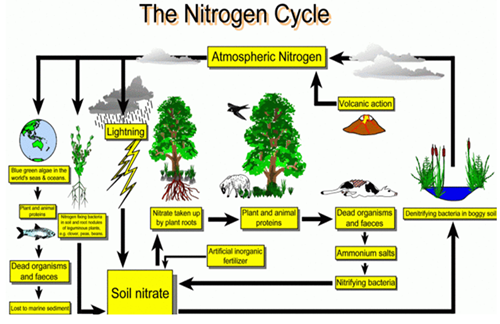Microorganisms - Chapter Wise CBSE Solved Question and Answer Based On NCERT
The nitrogen cycle is the process by which nitrogen is converted between its various chemical forms.Nitrogen is present in the environment in a wide variety of chemical forms including organic nitrogen, ammonium (NH4+), nitrite (NO2-), nitrate (NO3-), nitrous oxide (N2O), nitric oxide (NO) or inorganic nitrogen gas (N2), atmospheric nitrogen needs to be processed to be used by plants and animals. Some bacteria and blue green algae present In soil fix atmospheric nitrogen into nitrates which is used by plants from the soil through their root systemnitrogen is then used for synthesis of plant proteins and other compounds,when plants and animals die bacteria and fungi present in soil convert the nitrogenous waste into nitrogen compounds to be used by plants again, some bacteria converts some part of them into nitrogen gas which goes back into the atmosphere, thus percentage of nitrogen in atmosphere remains more or less constant.

Microorganisms are beneficial to us in various ways; they not only prepare curd, bread, cake, wine and medicines for us but also used to increase soil fertility by fixing atmospheric nitrogen. Thus we called them as friendly.
Yeast reproduces rapidly and produces carbon dioxide during respiration. Bubbles of gas fill the dough (mixture of atta or maida and some sugar and water) and increase its volume. This is the basis of using yeast in baking industry.
Fermentation is the process of food processing in which sugar is converted into alcohol by the action of microorganisms. This process is used to produce alcoholic beverages such as wine, beer, and cider. For this purpose yeast is grown on natural sugars present in grains like barley, wheat, rice, crushed fruit juices etc.
Antibiotics are medicines that kill or stop the growth of disease causing microorganisms and they are prepared from microorganisms. For e.g. streptomycin, tetracycline and penicillin are some of the antibiotics prepared from microorganisms like fungi and bacteria.
Some microorganisms cause diseases in human beings, plants and animals, like somespecies of bacteria causes tuberculosis and typhoid, some species of virus causes common cold and influenza. Some microorganisms also cause spoilage of food, clothing and leather items. Thus we consider some microorganisms are harmful.
Diseases causing microorganisms can enter our body through the air we breathe, water we drink and the food we eat. They can also get transmitted by direct contact through an infected person or carried through an animal.
There are some microorganisms that cause disease in animals also like anthrax is a very dangerous human and cattle disease caused by a bacterium. Foot and mouth disease of cattle is caused by a virus.
There are some microorganisms that cause disease in plants like wheat, sugarcane, rice, potato, orange, and apple. Like citrus canker disease caused by bacteria in plant, rust of wheat disease in wheat plant caused by fungi. These diseases reduce the yield of crops and can be controlled by using certain chemicals that kill microbes.
It is because of food poisoning. Food poisoning could be due to the consumption of food spoilt by some microorganisms.
Antibiotics should be taken only on the advice of an expert and qualified doctor. One should must complete the course prescribed by the doctor. Taking antibiotics in wrong dose or taking it when it is not needed makes it less effective when it is required in future. Also unnecessarily uptake of antibiotics may kill the useful bacteria inside the body.one should keep in mind that antibiotics are not effective against cold and flu as these are caused by viruses.
Microorganisms are broadly divided into four major groups namely: Bacteria, virus, fungi and virus.
Bacteria are single- celled microscopic organisms. They can survive under all types of environment, ranging from ice cold climate to hot springs and deserts to marshy lands. Bacteria always live in colonies. They are of spiral shape or rod shape. Bacteria play important role in our life; some bacteria are useful whereas some other are harmful and cause diseases. Bacteria are involved in making of cheese and pickles. Lactobacillus bacteria promote the formation of curd. Antibiotics are also made from bacteria. Apart from this diseases like tuberculosis and typhoid are caused due to bacteria.
Viruses are microscopic infectious agent that acts as non-living outside host cell and inside host cell becomes living and show reproduction. It can affect all kind of organism including animals, plants and bacteria. Common ailments like cold, coughs and influenza (flu) are caused by viruses; serious diseases like chicken pox and polio are also caused by viruses.
Protozoa had been defined as unicellularprotists with animal-like behaviour like movement. The largest protozoa known are the deep-sea dwellingxenophyophores, which can grow up to 20 cm in diameter.They move around with whip-like tails called flagella, and hair-like structures called cilia,it is responsible for causing diseases like dysentery and malaria in human beings.
Algae are a very large and diverse group of simple, typicallyautotrophic organisms, ranging from unicellular to multicellular forms. Most are photosynthetic like plants, and "simple" because their tissues are not organized into many distinct organs found in land plants. The largest and most complex marine forms are called seaweeds.Algae exhibit a wide range of reproductive strategies, from simple, asexual cell division to complex forms of sexual reproduction.Nearly all algae have photosynthetic machinery ultimately derived from cyanobacteria, and so produce oxygen as a by-product of photosynthesis.
| Chapter 2 | Microorganisms |